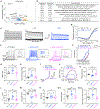Severe deficiency of the voltage-gated sodium channel NaV1.2 elevates neuronal excitability in adult mice
- PMID: 34348148
- PMCID: PMC8382316
- DOI: 10.1016/j.celrep.2021.109495
Severe deficiency of the voltage-gated sodium channel NaV1.2 elevates neuronal excitability in adult mice
Abstract
Scn2a encodes the voltage-gated sodium channel NaV1.2, a main mediator of neuronal action potential firing. The current paradigm suggests that NaV1.2 gain-of-function variants enhance neuronal excitability, resulting in epilepsy, whereas NaV1.2 deficiency impairs neuronal excitability, contributing to autism. However, this paradigm does not explain why ∼20%-30% of individuals with NaV1.2 deficiency still develop seizures. Here, we report the counterintuitive finding that severe NaV1.2 deficiency results in increased neuronal excitability. Using a NaV1.2-deficient mouse model, we show enhanced intrinsic excitability of principal neurons in the prefrontal cortex and striatum, brain regions known to be involved in Scn2a-related seizures. This increased excitability is autonomous and reversible by genetic restoration of Scn2a expression in adult mice. RNA sequencing reveals downregulation of multiple potassium channels, including KV1.1. Correspondingly, KV channel openers alleviate the hyperexcitability of NaV1.2-deficient neurons. This unexpected neuronal hyperexcitability may serve as a cellular basis underlying NaV1.2 deficiency-related seizures.
Keywords: K(V)1.1; Na(V)1.2; SCN2A/Scn2a; epilepsy; gene trap; neuronal excitability; potassium channel; voltage-gated sodium channel.
Copyright © 2021 The Authors. Published by Elsevier Inc. All rights reserved.
Conflict of interest statement
Declaration of interests The authors declare no competing interests.
Figures




Comment in
-
The NaVy paradox: reducing sodium currents increases excitability.Trends Neurosci. 2021 Oct;44(10):767-768. doi: 10.1016/j.tins.2021.07.008. Epub 2021 Aug 6. Trends Neurosci. 2021. PMID: 34373125 Free PMC article.
Similar articles
-
Hyperexcitability in adult mice with severe deficiency in NaV1.2 channels.Int J Physiol Pathophysiol Pharmacol. 2022 Feb 15;14(1):55-59. eCollection 2022. Int J Physiol Pathophysiol Pharmacol. 2022. PMID: 35310859 Free PMC article.
-
Hyperexcitability and Pharmacological Responsiveness of Cortical Neurons Derived from Human iPSCs Carrying Epilepsy-Associated Sodium Channel Nav1.2-L1342P Genetic Variant.J Neurosci. 2021 Dec 8;41(49):10194-10208. doi: 10.1523/JNEUROSCI.0564-21.2021. Epub 2021 Oct 29. J Neurosci. 2021. PMID: 34716231 Free PMC article.
-
CaMKII modulates sodium current in neurons from epileptic Scn2a mutant mice.Proc Natl Acad Sci U S A. 2017 Feb 14;114(7):1696-1701. doi: 10.1073/pnas.1615774114. Epub 2017 Jan 30. Proc Natl Acad Sci U S A. 2017. PMID: 28137877 Free PMC article.
-
NaV1.1 channels and epilepsy.J Physiol. 2010 Jun 1;588(Pt 11):1849-59. doi: 10.1113/jphysiol.2010.187484. Epub 2010 Mar 1. J Physiol. 2010. PMID: 20194124 Free PMC article. Review.
-
Progress in Understanding and Treating SCN2A-Mediated Disorders.Trends Neurosci. 2018 Jul;41(7):442-456. doi: 10.1016/j.tins.2018.03.011. Epub 2018 Apr 23. Trends Neurosci. 2018. PMID: 29691040 Free PMC article. Review.
Cited by
-
Developmental and epileptic encephalopathies: from genetic heterogeneity to phenotypic continuum.Physiol Rev. 2023 Jan 1;103(1):433-513. doi: 10.1152/physrev.00063.2021. Epub 2022 Aug 11. Physiol Rev. 2023. PMID: 35951482 Free PMC article. Review.
-
Microglial over-pruning of synapses during development in autism-associated SCN2A-deficient mice and human cerebral organoids.Res Sq [Preprint]. 2023 Sep 28:rs.3.rs-3270664. doi: 10.21203/rs.3.rs-3270664/v1. Res Sq. 2023. Update in: Mol Psychiatry. 2024 Aug;29(8):2424-2437. doi: 10.1038/s41380-024-02518-4. PMID: 37841865 Free PMC article. Updated. Preprint.
-
Heterozygous expression of a Kcnt1 gain-of-function variant has differential effects on SST- and PV-expressing cortical GABAergic neurons.bioRxiv [Preprint]. 2024 Aug 2:2023.10.11.561953. doi: 10.1101/2023.10.11.561953. bioRxiv. 2024. Update in: Elife. 2024 Oct 11;13:RP92915. doi: 10.7554/eLife.92915. PMID: 37873369 Free PMC article. Updated. Preprint.
-
Scn2a insufficiency alters spontaneous neuronal Ca2+ activity in somatosensory cortex during wakefulness.iScience. 2023 Oct 5;26(11):108138. doi: 10.1016/j.isci.2023.108138. eCollection 2023 Nov 17. iScience. 2023. PMID: 37876801 Free PMC article.
-
A Novel Ubiquitin Ligase Adaptor PTPRN Suppresses Seizure Susceptibility through Endocytosis of NaV1.2 Sodium Channels.Adv Sci (Weinh). 2024 Aug;11(29):e2400560. doi: 10.1002/advs.202400560. Epub 2024 Jun 14. Adv Sci (Weinh). 2024. PMID: 38874331 Free PMC article.
References
-
- Alessi C, Raspanti A, and Magistretti J (2016). Two distinct types of depolarizing afterpotentials are differentially expressed in stellate and pyramidal-like neurons of entorhinal-cortex layer II. Hippocampus 26, 380–404. - PubMed
-
- Andrews S (2010). FastQC: a quality control tool for high throughput sequence data. https://www.bioinformatics.babraham.ac.uk/projects/fastqc/.
-
- Aupy J, Wendling F, Taylor K, Bulacio J, Gonzalez-Martinez J, and Chauvel P (2019). Cortico-striatal synchronization in human focal seizures. Brain 142, 1282–1295. - PubMed
Publication types
MeSH terms
Substances
Grants and funding
LinkOut - more resources
Full Text Sources
Medical
Molecular Biology Databases
Research Materials

